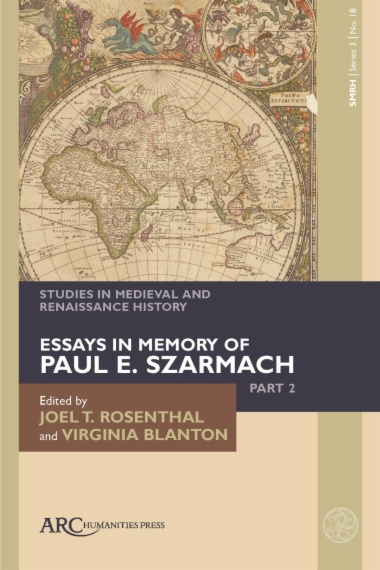Studies in Medieval and Renaissance History is an annual publication of historiographical essays on the pre-modern world. As a venue for sustained investigations, it plays a significant role in the dissemination of interpretative scholarship that falls in the niche between the journal article and the monograph.
This is the final volume in series 3 and primarily comprises essays in memory of Paul E. Szarmach, the eminent Old English scholar and former executive director of the Medieval Academy of America and director of the Medieval Institute at Western Michigan University, Kalamazoo.
- Contents
- Introduction
- Chapter 1: The Development of Constantinian Themes and Their Manifestation in Writings and Coinages of Early England
- Chapter 2: Echo and Icon: Life in Stone at Bewcastle, Cumbria
- Chapter 3: Jerome of Strido at Chelles:
The Legacy of Quedlinburg Codex 74
- Chapter 4: Revisiting the Maaseik Zoomorphic Embroideries
- Chapter 5: The Old English Version of Alexander’s Letter to Aristoteles and its Use of Binomials
- Chapter 6: Agency and Obedience: The Afterlife of St. Swithun in Anglo-Saxon England
- Chapter 7: B. and the Vita Harlindis et Renulae
- Chapter 8: Wheelock’s Bede and Its Supplementary Materials: Goals and Methods
- List of Illustrations
- Figure 1.1: Bronze Nummus of Constantine I struck at London ca. 311–312; and Silver Penny of Æthelred II struck at Thetford ca. 1003–1009. Photograph by Robert Schichler.
- Figure 2.1: The Blowing Stone. Photograph by Rob Bradford, CC BY-SA 2.0.
- Figure 2.2: The Ruthwell Cross, Dumfries. Photograph by Catherine E. Karkov.
- Figure 2.3: The Bewcastle Cross, Cumberland, west side. Photograph by Catherine E. Karkov.
- Figure 2.4: The Bewcastle Cross, east side. Photograph by Heidi Stoner. Used with permission.
- Figure 2.5: Detail of the Bewcastle Cross with lichen. Photograph by Heidi Stoner. Used with permission.
- Figure 3.1: Opening of item VI, Origen’s second homily on Song of Songs, translated by Jerome. Halle (Saale), Universitäts- und Landesbibliothek Sachsen-Anhalt, Quedlinburg Codex 74, fol. 10r. CC BY 4.0.4
- Figure 3.2: Typical scribal annotation marks. Halle (Saale), Universitäts- und Landesbibliothek Sachsen-Anhalt, Quedlinburg Codex 74, fol. 91v. CC BY 4.0.
- Figure 3.3: Halle (Saale), Universitäts- und Landesbibliothek Sachsen-Anhalt, Quedlinburg Codex 74, fol. 306r. CC BY 4.0.
- Figure 3.4: Paris, Bibliothèque nationale de France, MS Latin 1869, fol. 73v.
- Figure 3.5: Halle (Saale), Universitäts- und Landesbibliothek Sachsen-Anhalt, Quedlinburg Codex 74, fol. 30r. CC BY 4.0.
- Figure 3.6: Paris, Bibliothèque nationale de France, MS Latin 1869, fol. 185v. Photograph by Helene Scheck.
- Figure 3.7: Halle (Saale), Universitäts- und Landesbibliothek Sachsen-Anhalt, Quedlinburg Codex 74, fol. 88v. CC BY 4.0.
- Figure 3.8: Paris, Bibliothèque nationale de France, MS Latin 1869, fol. 229r.
- Figure 4.1: The casula of Saints Harlindis and Relindis, composite textile. Maaseik, Belgium, Church of St. Catherine. Image G002090 © KIK-IRPA, Brussels. Used with permission.
- Figure 4.2: The Arcade strips, silk embroidery on linen, late eighth or early ninth century. Top: A, the shorter strip. Bottom: B, the longer strip. Image X085891 © KIK-IRPA, Brussels. Used with permission.
- Figure 4.3: Inhabited horizontal scroll, fragment of a stone frieze, pre-Viking. Breedon-on-the-Hill, Leicestershire, United Kingdom, Church of St. Mary and St. Hardulph. Photo by Joanna Story and the Corpus of Anglo-Saxon Sculpture. Used with permission.
- Figure 4.4: Roundel strip A, silk embroidery on linen, late eighth or early ninth century. Image X085898 © KIK-IRPA, Brussels. Used with permission.
- Figure 4.5: Roundel strip B, silk embroidery on linen, late eighth or early ninth century. Image X085901 © KIK-IRPA, Brussels. Used with permission.
- Figure 8.1: Opening entries of the G section of Wheelock’s subject index for the manuscript. Cambridge, Cambridge University Library, MS Ii. 4. 6, fol. 316r (detail). Used with permission of the Syndics of Cambridge University Library.
- Figure 8.2: Opening of Wheelock’s transcript of the first section of Ælfric’s First Series homily for the Assumption. Cambridge, Cambridge University Library, MS Gg. 3. 28, verso of the second of eight leaves inserted by Wheelock after fol. 94. Used with

